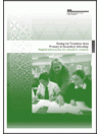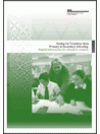The present report is the last in a series of three. Each report presents findings from a Ministry of Education project A Study of Students’ Transition from Primary to Secondary Schooling.
Key Results
- Most students quite quickly adapted to the more immediate changes inherent in a move from primary to secondary school, such as finding their way around in the new school, moving classes, becoming familiar with different rules and routines, and making new friends.
- Also, by the end of their first year at secondary school:
- overall, Year 9 students reported many positive experiences at school;
- in the majority of cases, after a dip earlier in the year, in mathematics in particular, students’ asTTle3 test results revealed sound or good achievement gains; and
- few students expressed a desire to ‘go back to how things were’ at primary or intermediate school.
- But, at the same time, the Year 8–9 transition represented a time of significant, deeper-level change and was generally ‘unsettling’ for students.
- Other significant findings included that for an important minority of students (around 10%), the Year 8 to Year 9 transition was a particularly challenging time, academically and/or socially, and exacerbated in some cases by emotional issues or difficult home circumstances. Late in Year 9, some of these students continued to express a preference for primary over secondary schooling.
- Evidence from other recent studies, as well as the transition study itself, show that during the middle years of schooling (Years 7 to 10) more vulnerable students in terms of their progress and well-being at school tend to become increasingly disengaged from learning and from school generally. This puts them at particular risk of achieving few if any qualifications to equip them for a positive future and of dropping out of school altogether.


